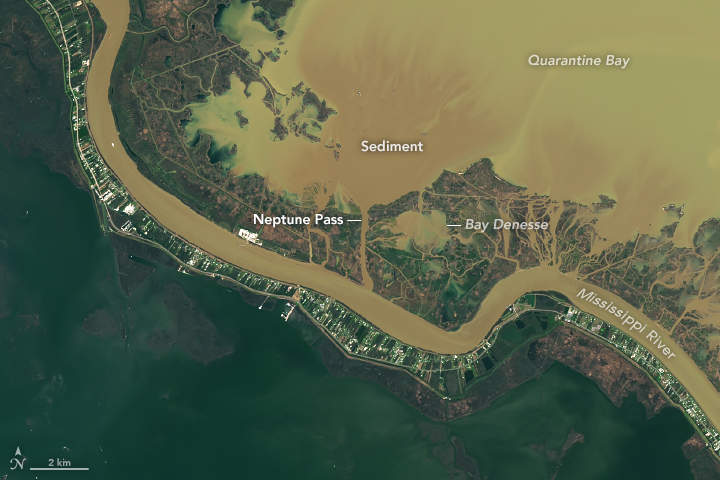
With the state losing significant parcels of land along its coast, coastal restoration projects remain critical to its future. Plagued with expensive price tags, these projects often stall or fall victim to bureaucratic red tape.
Every once in a while, Mother Nature recognizes a need and serves up her own solution. What once initiated as little more than a ditch connecting the Mississippi River and Quarantine Bay, Neptune Pass has grown into a broad and deep channel that carries approximately 15 percent of the river’s flow.

“It’s the largest new outlet of the Mississippi to form in decades, really since the historic 1927 flood,” said Dr. Alex Kolker, Ph.D., and associate professor at the Louisiana Universities Marine Consortium.
Remarkable growth
Kolker took advantage of idle time levied by the pandemic in 2020 and began studying satellite imagery of coastal Louisiana. He realized the remarkable growth induced by Neptune Pass. He indicates the most profound depth of 100 feet and approximately 600 feet at its widest point. Kolker suggests its impressive growth serves as an understanding of Mother Nature’s coastal restoration project in play.
“It functions like a diversion,” said Kolker. “This is how land was built all over coastal Louisiana.”
With the volume of water flowing through Neptune Pass, a new delta of 1,000 acres or more continues to build at Neptune Pass’ mouth at Quarantine Bay. Portions of the river’s rich silt can protrude the water’s surface at low tide, and at high tide, the new land growth remains submerged just slightly below the surface.
In addition to land growth, Kolker recognizes the significant potential for Louisiana sportsmen. The new acreage serves as a habitat for shellfish to breed and an additional migration point for waterfowl.
Moving land
Although a work of ecological wonder, the natural development of Neptune Pass finds itself in peril. Because the Mississippi River is a primary shipping channel, the United States Army Corp of Engineers implemented temporary measures to control the expansion and continues to develop a long-term and permanent solution.
“We have what is like a redistribution of land where the channel widens,” said Ricky Boyett, Army Corp of Engineers chief of public affairs. “It’s beginning to impact navigation by implementing a vacuum effect on vessels.”
According to Boyett, the Corp’s goal is only influenced in response to navigation concerns and seeks to restore conditions before river flooding waged in 2019. The organization focuses on developing a stabilization measure.
“We need to do more modeling and generate a practical design,” said Boyett when discussing a long-term strategy after the Corp’s previous rock distribution to protect clay layers.
Kolker describes the current state of Neptune Pass’ future as the attempt to implement a balance between the benefits of land rebuilding and safety. The Corps said remaining stationary and allowing Neptune Pass to continue to grow could increase the negative impact on shipping and spark the need for costly dredging. But depending on the final solution levied by the Corps, coastal restoration and wildlife and fisheries benefits could suffer.
“The Corps’ proposal is in keeping with their charge of maintaining navigational access for the Mississippi River,” said Mike Wood, professional fisheries biologist. “I don’t think the project will damage current fish and wildlife resources any more than they already have been.
However, improvements that would have resulted from marsh restoration will be prevented,” Wood said.
